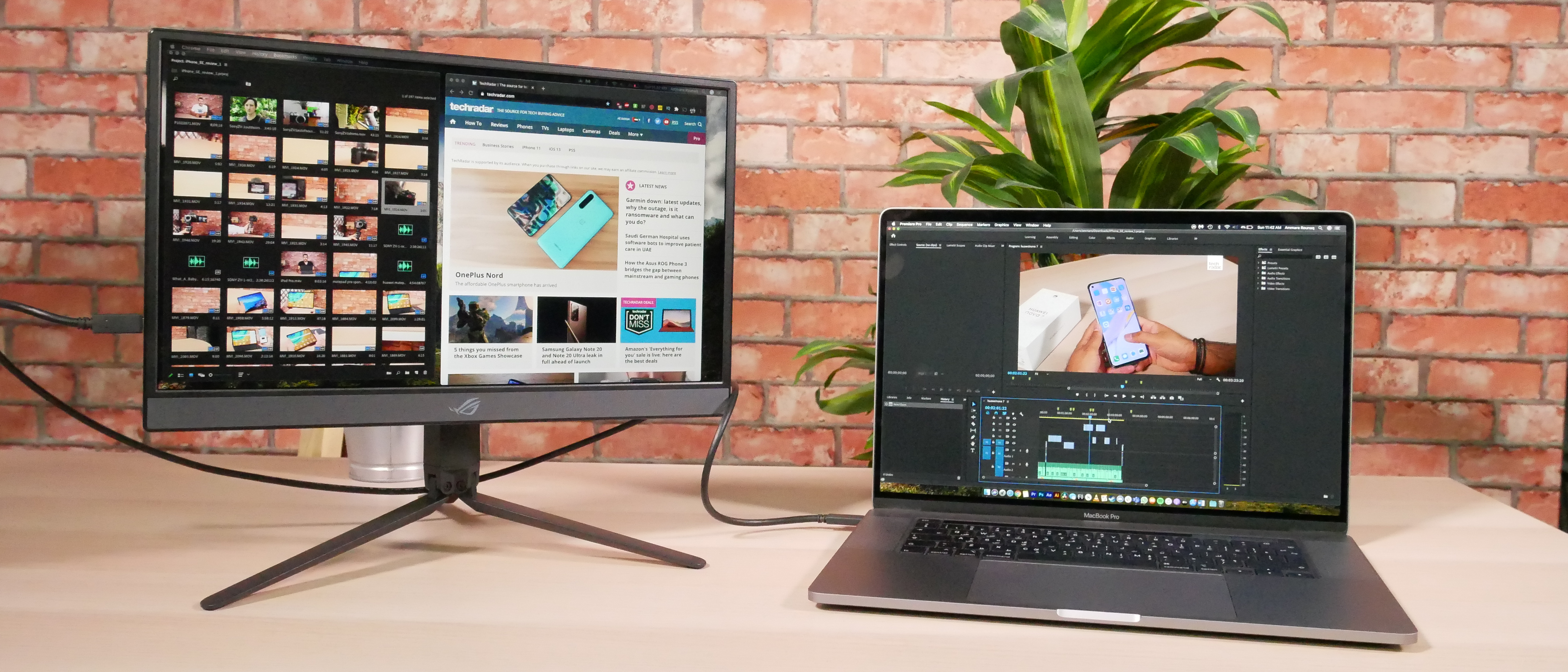TechRadar Verdict
The Asus ROG Strix XG17 brings blazing fast refresh rates and good image quality for traveling gamers who want to play competitively on the move. But it’s expensive, and you can get your hands on a larger 240Hz desktop monitor for less.
Pros
- +
Zippy 240Hz display
- +
Slim and lightweight
- +
Built-in battery
Cons
- -
Expensive
- -
Flimsy magnetic case
Why you can trust TechRadar
Two-minute review
Asus is no stranger to portable monitors, with their excellent albeit pricey ZenScreen USB-C monitors topping our list for the best portable displays out right now. With the Asus ROG Strix XG17, the brand takes a gaming-focused approach and has created a no-compromise portable gaming monitor for the most dedicated players.
The Asus ROG Strix XG17 packs a crisp, 17.3-inch Full HD IPS display with a 240Hz refresh rate and built-in battery. It has a slim, portable build that you can take anywhere, especially if you play games on a competitive level or need a convenient option for streaming on the go. You can use the ROG Strix XG17 to play games and use your laptop’s screen to keep an eye on chat, or vice versa.
Gaming on a 240Hz monitor opens up a host of possibilities for first person shooter games and esports. Competitive players are mostly interested in monitors with fast refresh rates and quick response times that can keep up with how fast they play, without distractions such as motion trails which can make visuals blurry and ghosting.
There are two ways to prop up the ROG Strix XG17. You can use the origami magnetic case which can be folded to in landscape or portrait orientation. It only covers one side of the monitor, leaving most of the display exposed and as a stand it’s feeble at best. Alternatively you can use the sturdier and more stable tripod stand and use the bundled carry bag to keep the ROG Strix XG17 safe while you’re on the move.
Display performance is great for a portable monitor - images are smooth with no noticeable stuttering. It gets plenty bright with crisp color reproduction and has great viewing angles, allowing you to use it as an extra screen for work or for co-op sessions with a friend.
The two 1W front-firing speakers get decently loud as well, reaching higher volume levels than what you’d get with your phone or laptop and come in especially handy when connected to consoles. You’ll have no issues determining which direction a gunshot is coming from or follow a character’s echoes. But if that’s not sufficient, you can always plug in your favorite pair of wired earphones via the 3.5mm headphone jack on the display.
There’s an easy to access OSD baked in the monitor that gives you a ton of options to calibrate the display to your liking, including toggling FreeSync, a GamePlus menu with crosshairs, FPS and display alignment as well Shadow Boost that clarifies dark areas without overexposing bright ones.
What we ended up with is a device that’s made for a specific kind of user, which it makes it hard to recommend to casual users or someone looking for a cost-effective way to expand their screen space. $500 is a massive ask when there are top quality 240Hz desktop monitors available for less. But for gamers with the need for it, there’s literally no other portable display like it.
Pricing and Availability
The Asus ROG Strix XG17 retails for $600 (AED2,200). For that price, you get a high-end 17.3-inch Full HD display, a magnetic case that doubles as a stand, a tripod stand and a carry bag.
By comparison, the Asus ZenScreen Go retails at just under AED 1,450 for a Full HD IPS screen running at a paltry 60Hz. There are cheaper options still like the Lenovo ThinkVision M14 or AOC’s 16-inch USB monitor, if you don’t care about fast refresh rates.
If you do care about a fast display, then you can grab a high-end desktop 240Hz monitor between 24 to 27-inches with all the bells and whistles for less than ROG Strix 17 from the likes of Samsung, Alienware and even Asus themselves.
Design
Larger than most portable displays at 17.3-inch, the Asus ROG Strix will naturally take up more room on your desk. But the extra screen space comes in handy when you want to immerse yourself in a game or fit in another app window while working.
It’s slim at just 0.4-inches thin and weighs approximately 1kg, which means you can slip it into a backpack or laptop case. It’s also sturdy, despite being lightweight with almost no flex or bend. Those working in cramped spaces will appreciate the ease with which you can connect and setup the Asus ROG Strix XG17 anywhere around your home, airport lounge, or at a cafe.
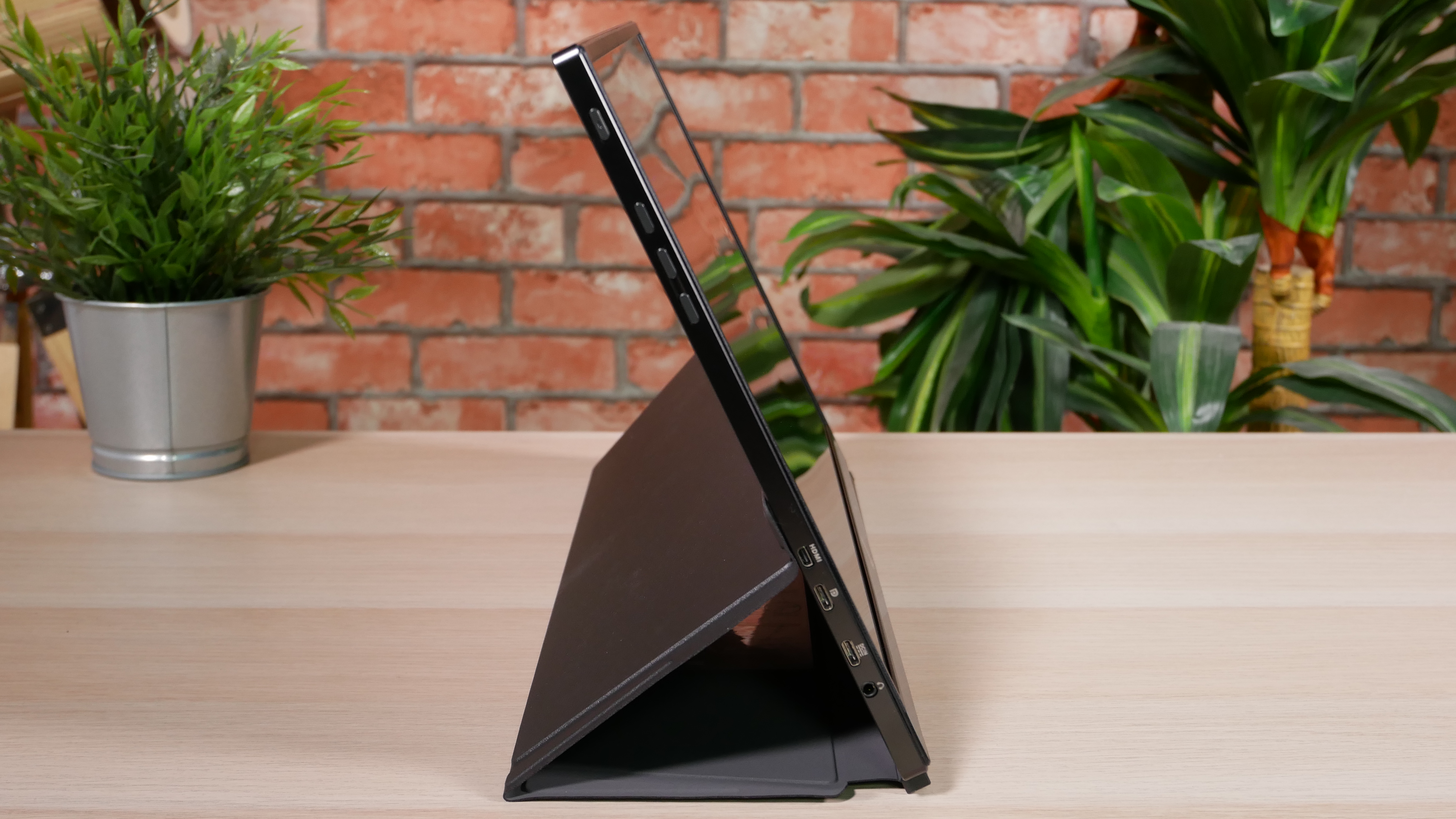
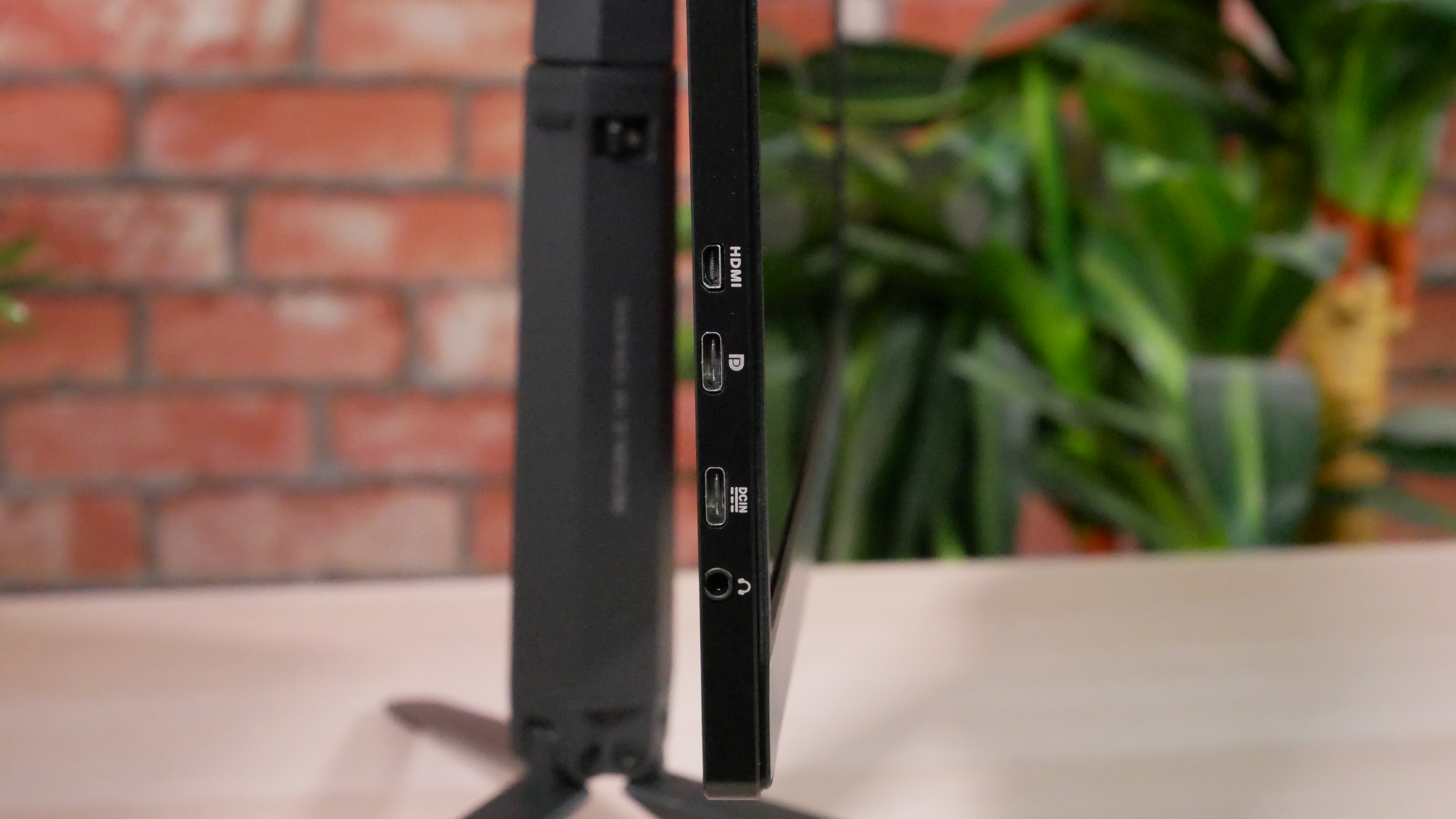

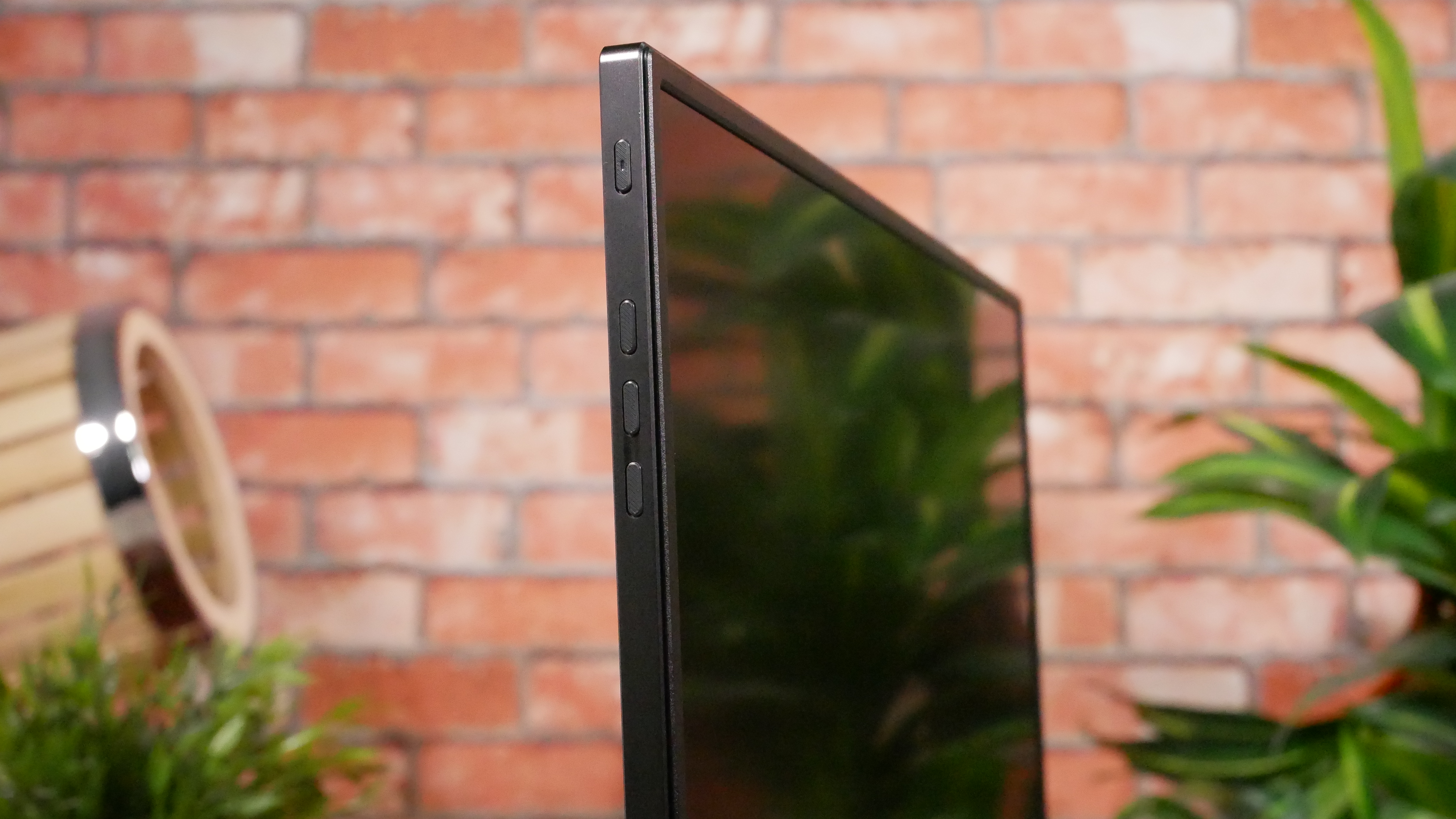
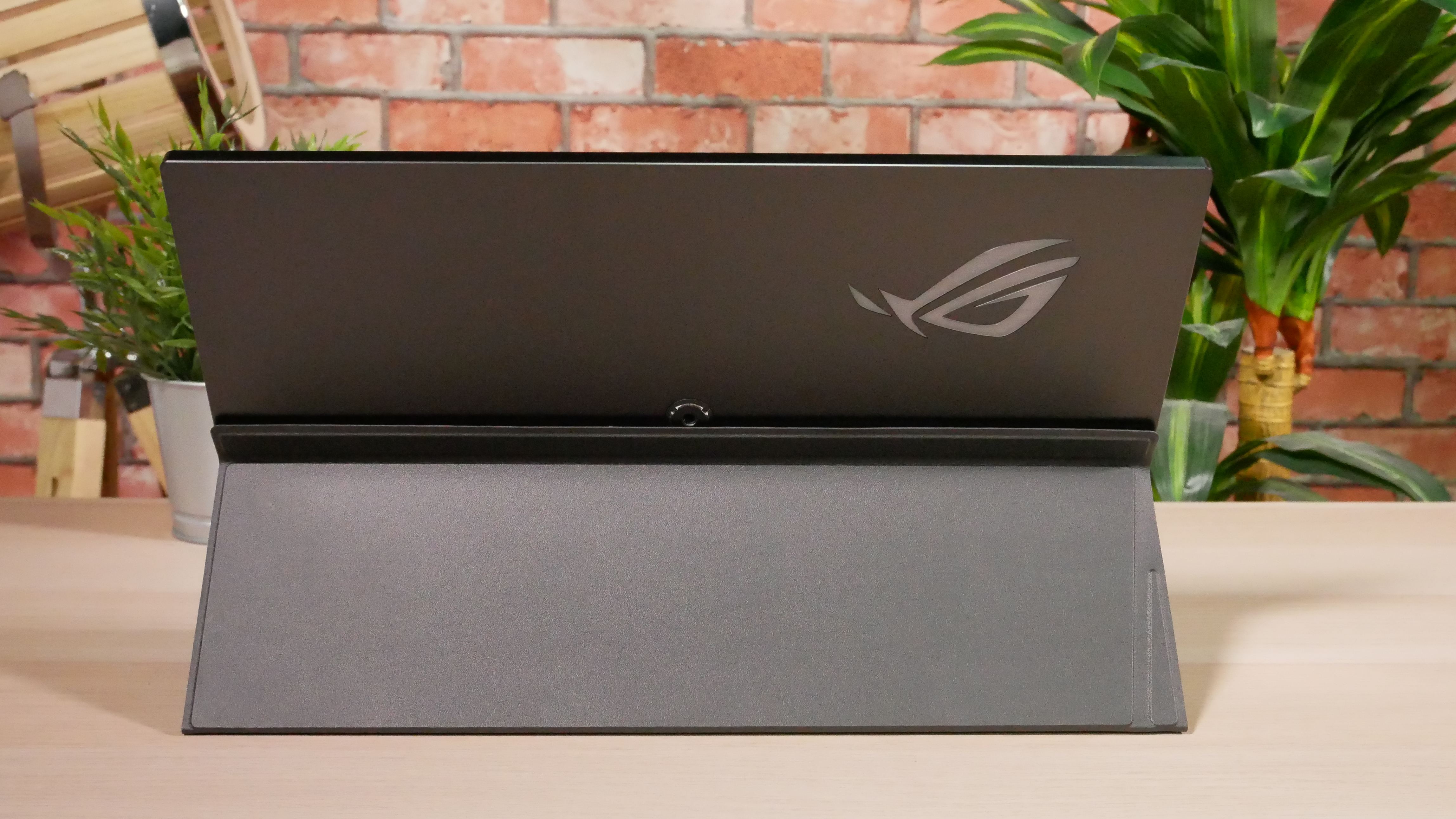
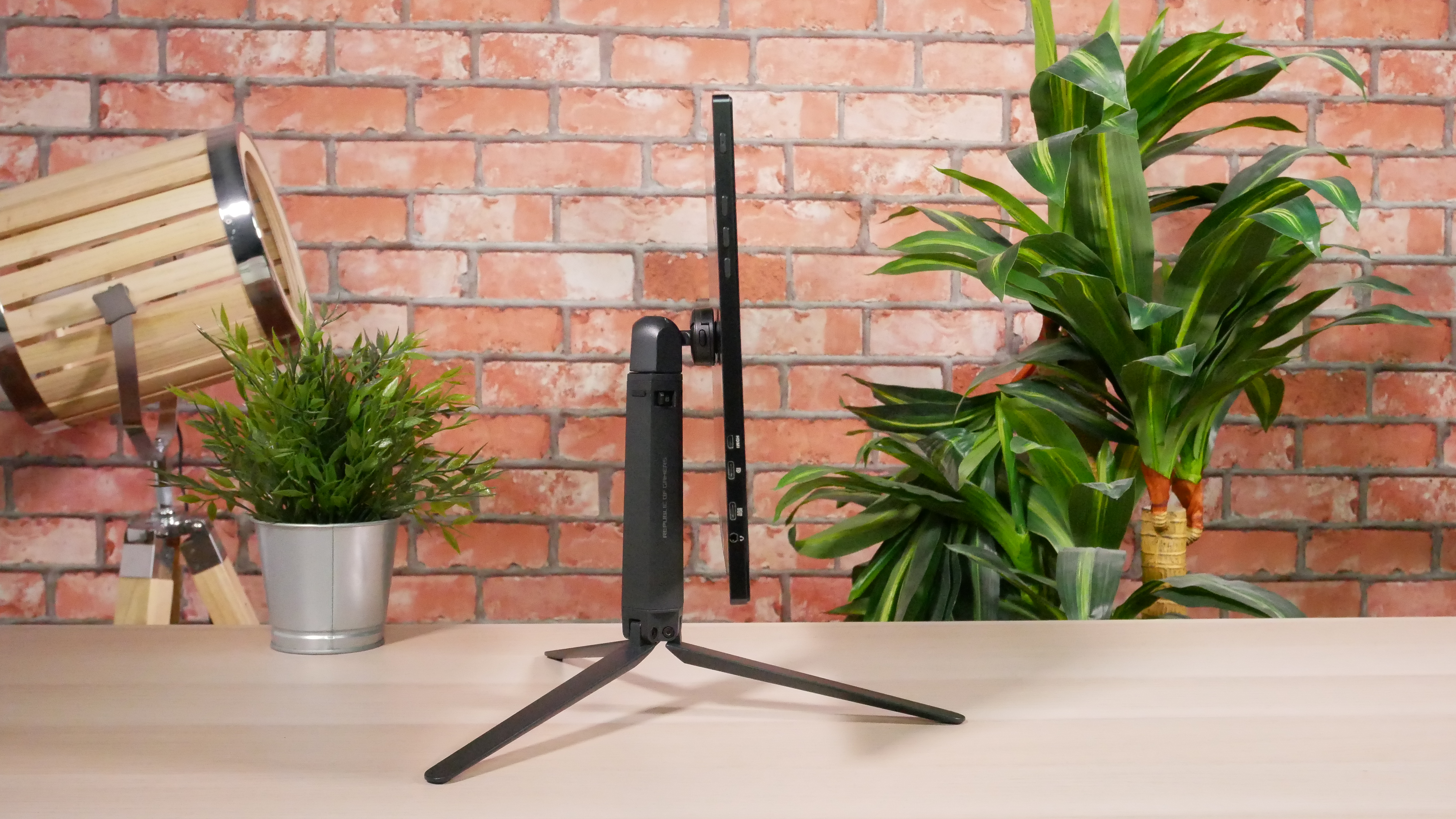
Larger than most portable displays at 17.3-inch, the Asus ROG Strix will naturally take up more room on your desk. But the extra screen space comes in handy when you want to immerse yourself in a game or fit in another app window while working.
It’s slim at just 0.4-inches thin and weighs approximately 1kg, which means you can slip it into a backpack or laptop case. It’s also sturdy, despite being lightweight with almost no flex or bend. Those working in cramped spaces will appreciate the ease with which you can connect and setup the Asus ROG Strix XG17 anywhere around your home, airport lounge, or at a cafe.
Design-wise, the portable monitor has all the classic Asus polish found on its ZenBooks, with a splash of premium in the form of ROG logos on the front and back. There’s no garish ‘gamer’ design as Asus keeps things minimal and elegant with an aluminum build and textured metallic finish that’s smooth to touch.
There are narrow bezels around the display to keep your focus solely to the content that’s displayed on the screen. At the bottom is a thin speaker grille that houses the ROG Strix’s two 1W speakers.
On the left, you’ll find the power button and volume rockers that are also used to navigate the display’s OSD menu. These work fine for the most part but not as well as the convenient 5-way mini-joystick buttons found on other Asus monitors.
Just below that are a couple of USB-C ports and a mini-HDMI port, your only means of connectivity and frankly all you need. You can use a USB-C cable to connect tablets, phones or a PC / laptop that supports direct USB-C connection to a display.
You can use either USB-C port to power the ROG Strix XG17 but only one USB-C port comes with support for Power Delivery 3.0, which means it can siphon charge from your laptop if your laptop has USB-C ports that can charge other devices. This way you’ll never have to worry about the display running out of battery, and simplify things by only having to deal with your laptop’s power cables.

Alongside the USB-C ports is a mini-HDMI port that allows you to connect a variety of devices ranging from game consoles, desktops to cameras. You’ll be able to run the display off the built-in battery when using HDMI, and when the display runs out of juice you can simultaneously power it through a USB-C cable.
Bundled with the monitor is a smart magnetic cover that doubles as an origami stand. The magnets on the case feel weak, and you’ll have to fumble a bit to get the case to attach to the back of the display and form a sturdy stand.
A better way to prop up the display is the tripod-style mount that also comes bundled with the monitor. The only issue with that is it doesn't screw the display tightly enough at the back so you might see some tilt and sway.

The buttons used to navigate the OSD menu on the ROG Strix XG17 can feel flat and hollow to use, making navigation a bit fiddly. But once you get used to them, you’ll have access to a surprisingly comprehensive settings menu that let you calibrate the display to your liking.
You have the standard input and image settings that let you select input source, adjust brightness, contrast and mess around with color temperature. There’s also an assortment of modes and options under the Gaming section that features dedicated image modes, five levels of overdrive, toggling FreeSync, a GamePlus menu that lets you tweak display alignment, add an fps counter, timer and crosshair.
Display Performance & Speakers
The Asus ROG Strix XG17 packs a Full HD 17.3-inch IPS display with support for 240Hz refresh rate and a response time of 3ms. It’s a bright screen with great viewing angles and works great as a second display for working on documents and playing games, no matter where you place the display on your desk. With brightness cranked to max, you barely notice reflections when facing direct light.
Colors are vivid and vibrant and with a resolution of 127 inch pixels per inch, things on the screen appear crisp and clear. Playing through colorful games like Overwatch and Valorant, colors popped off the screen without looking oversaturated and remained distinct even in darker areas.
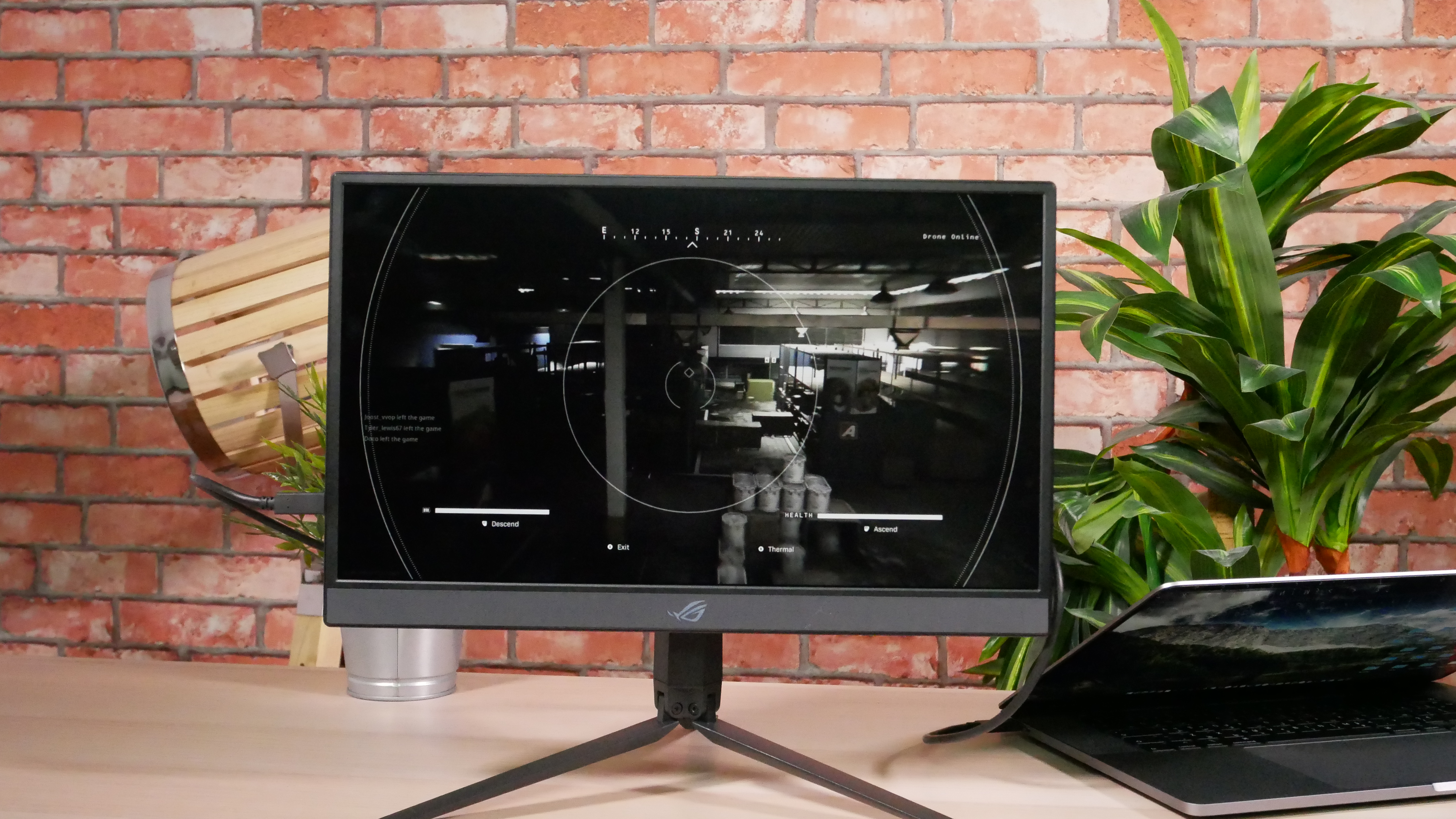
Where the monitor really shines is in its 240Hz display. We played CS:GO and Call of Duty: Warzone and loved the smoothness that came with a higher refresh rate. The monitor was thoroughly able to keep distractions like blurry visuals and ghosting at bay, even when things got intense on the screen.
Console games also feel smooth despite not being able to hit high fps rates. Playing Super Smash Bros on the Nintendo Switch was a delight as colors shone through vividly and Ghost of Tsushima on the PS4 looked incredible even when things got dark on the screen.
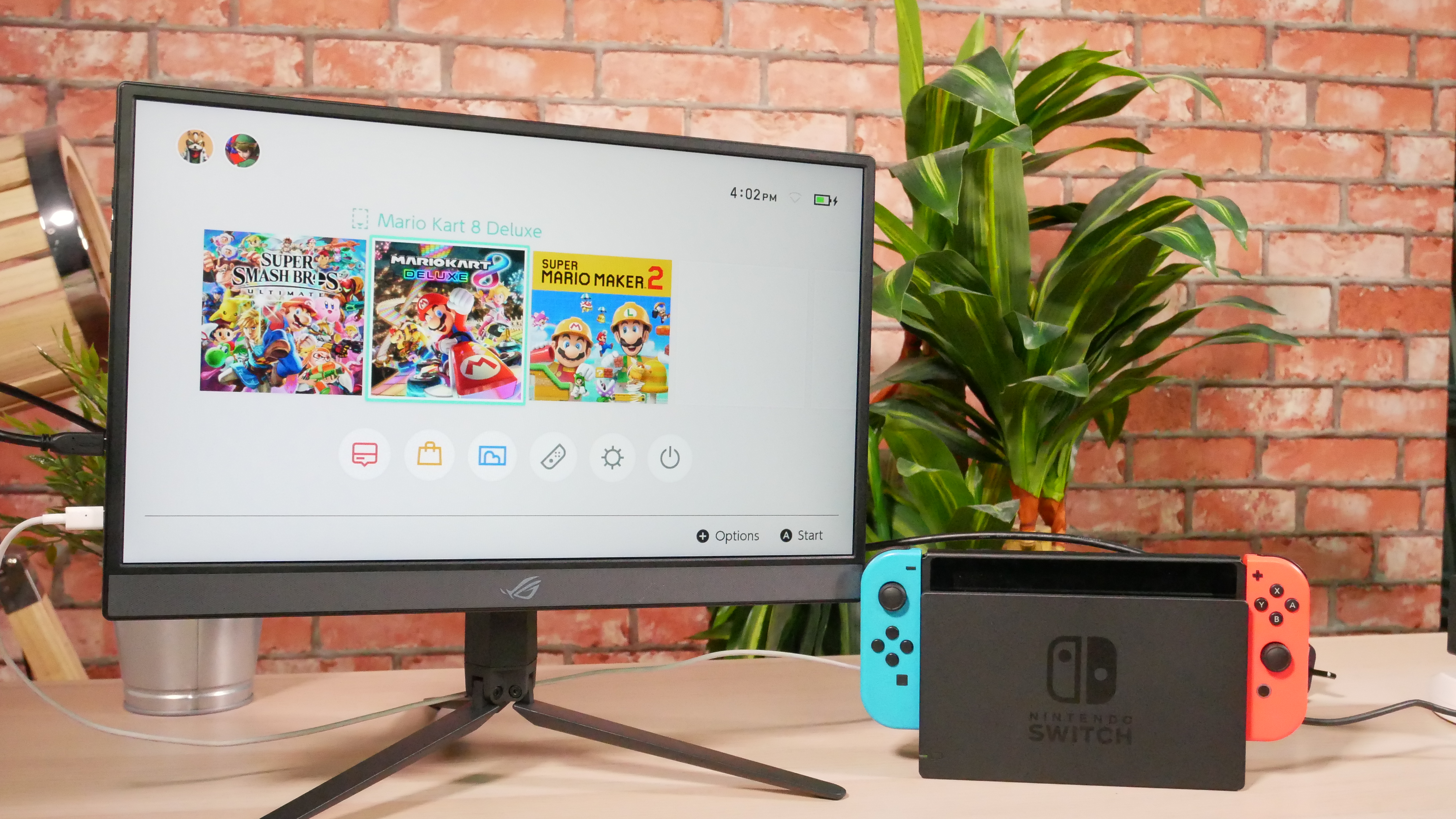
The speakers on the Asus ROG Strix XG17 are quite loud and clear enough to decipher game sounds and voice chat. We had no trouble making out sounds from different weapons, character movement, teammate chatter and environmental effects.
If your connected device has lackluster speakers, then the audio form ROG Strix XG17 will be a welcome upgrade. For even finer audio you can connect your favorite pair of wired earphones into the 3.5mm headphone jack on the display.
Battery Life
The Asus ROG Strix has a 7,800 mAh battery built-in, which lasts around 3 to 4 hours while running at 240Hz with brightness cranked to max and minimal speaker use. You can get almost 5 hours of use if you drop the refresh rate to 60Hz. With speaker use, the battery life drops down to a couple of hours.
If you’re connected to a laptop or console with USB ports that support Power Delivery 3.0, you can charge the monitor while using it. This is how we used the Asus ROG Strix XG17 and never saw battery drop while plugged into a Thunderbolt port on a MacBook Pro.
For times when you do run out of juice, there’s support for quick charge 3.0 that gets you back up to 61% with just an hour of charging. If you have a power bank or enough juice in your laptop, you can eke out a couple of hours on gaming fairly quickly.
Buy it if
You play a ton of competitive games and travel a lot
If you’re a pro or semi-pro gamer or someone who’s always on the move and looking to play games at a competitive level, the Asus ROG Strix XG17 was made exactly for you. It has a great assortment of ports that lets you connect all kinds of consoles, PCs and even your smartphone. And since it’s lightweight and slim, you’ll have no trouble lugging it around to LAN parties and events.
Portability is a priority
While you can get your hands on a high-quality desktop gaming monitor that costs less than the Asus ROG Strix XG17, you won’t be able to take it with you when you’re on the move. Asus keeps things small and simple, allowing you to quickly and easily plug your devices with USB-C and its built-in battery can charge off of your laptop reducing the amount of cables you’ll need to deal with.
Don’t buy it if
You have room for a desktop monitor
If you’re looking to add a second screen to your space or looking for a high quality display for your consoles, then you’ll definitely be better off with a dedicated gaming monitor instead of a portable display that’s more expensive.
You’re on a budget
The Asus ROG Strix XG17 is a great portable display with rich detail and crisp quality, but for the price it’s asking you can get your hands on a top-tier desktop monitor with the same 240Hz refresh rate with faster response times in a variety of screen sizes. If you’re still after something portable and don’t care about refresh rates, then you might want to look into other USB-C portable displays from Asus, AOC or Lenovo that are easier on the wallet and let you stay productive on the move.
Ammara is a tech and gaming writer with with an irrational love for all things Apple, indie games and cyberpunk novels. She handles social media for TechRadar Middle East with a keen interest in video creation and covers news and reviews across everything. Away from the keyboard, Ammara can be found playing the latest game and browsing for more tech gadgets she doesn’t need. She is also the current office Wordle champ.
